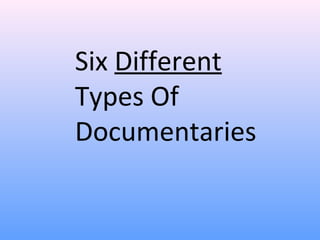
Modes of documentary[1]
- 2. Poetic Documentaries This sort of documentary was first produced in the 1920’s. Unlike many other types of documentaries poetic documentaries allow the audience to interoperate what they are seeing and allows there imagination to take over. It is open for them to take in what they are seeing and make judgement for themselves. They tend to have no voice over's , just sounds and music both dieagetic and non dieagetic. From the use of editing of scenes, images and clips it creates a story which you can follow, but things aren't as always simple as what they seem. The use of music is a huge factor in which changes your mood and tone whilst the story is being told. Here is a poetic documentary called Baraka http://www.youtube.com/watch?v=aH_N_ca27dU&feature=related
- 3. Expository Documentary This documentary is much more opinionated, and direct. It will generally have a voice over of the clips shown and will narrate what's going on in the documentary. Generally influence how you think and feel through out. In this type of documentary the narrator will speak whilst looking at the camera to make eye contact with their audience watchers. This is because they will be generally speaking in a persuasive form of tone and put across their opinion on what’s been saw. Therefore they are trying to persuade the audience to think and feel how they are feeling because they think we should all feel the same as them. In most of expository documentaries it will be a male voice because in the media industry it is seen as the ‘voice of God’ as God is seen as male and all powerful. Panorama Euro 2012: Stadiums of Hate http://www.bbc.co.uk/iplayer/episode/b01jk4vr/Panorama_Euro_2012_Stadiums_of_Hate /
- 4. Observational Documentary This documentary is to try and show how people really live and react to situations without being set up. Its the natural environment of things, what ever is being shown is real and a real situation. They try and film what every they can sometimes it leads to poor camera shots which seems less professional however it is just showing how things really are. This sort of documentary isn't to try and turn and sway peoples opinions as such but to give them a wider understanding and an insight to something they might have judged before looked into. Its job is to simply observe a lived life with a minimum of interruptions. By doing this the audience gets a real insight into the life instead of a fake and set up one. Filmmakers who worked in this sub-genre often saw the poetic mode as too abstract and the expository mode as too didactic Channel four documentary My Big Fat Gypsy Wedding http://www.channel4.com/program mes/big-fat-gypsy- weddings/4od#3325442
- 5. Reflexive Documentary This type of documentary is awareness of the process. Its mode acknowledges the constructed nature of the documentary and shows it to the people conveying to the audience that its not the necessarily truth but a reconstruction of what the truth is. The audience is aware that what is being shown is not the whole truth but it is the mode of the documentary. Reflective documentries don't see themselves as a transparent window on what the world can see but instead they draw attention to their own contractedness and the way they are represented. The Man With The Movie Camera Dziga Vertov (1929) http://www.youtube.com/watch ?v=8Fd_T4l2qaQ
- 6. Performative Documentary A performative documentary shows the emotions and subjective aspects of its documentary and shows all different types of ideas to create its context. This means its open for the audience to interoperate what they want and take different meanings from what's being shown. These types are often autobiographical. They are very personal and unconventional and they can include hypothetical events to make the audience experience what it may be like for us to possess a certain perspective on the world that is not our own. They can have a poetic feel to them so can confuse the audience. Here is an example: Supersize me Morgan Spurlock http://www.youtube.com/watch? v=mQj2u4ap5bo
- 7. Participatory Mode Unlike the documentary mode of observational, the participatory mode engages between the film maker and the issue/ subject in the documentary. The filmmaker himself becomes a big part in the events being recorded. The filmmakers involvement in the documentary is acknowledged and is often celebrated. Participatory documentries believe that it is impossible for the act of filmmaking to not influence or alter the events of being filmed. Not only is the filmmaker part of the film, we also get a sense of how the situations in the film are affected or altered by the presence of the film maker. Martin Bashir: Michael Jackson's "Secret World" part 1 http://www.youtube.com/watch?v=tsETlx9BCio